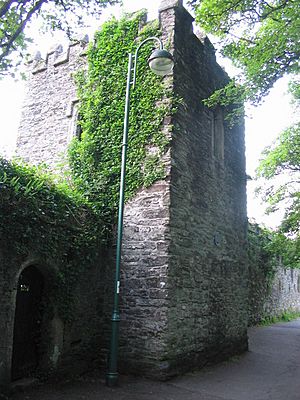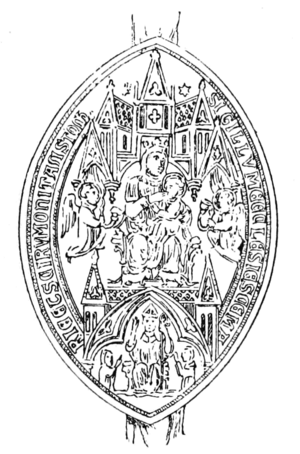Tavistock Abbey facts for kids
Tavistock Abbey, also known as the Abbey of Saint Mary and Saint Rumon, was once a large Benedictine abbey in Tavistock, Devon. Today, it is mostly in ruins. Only a few parts remain, like the old dining hall (called a refectory), two main entrances, and a porch.
The abbey church was built to honor Our Lady and Saint Rumon. Sadly, Danish raiders destroyed it in 997. It was rebuilt by the second abbot, Lyfing. The church was built again in 1285, and most of the abbey was rebuilt between 1457 and 1458.
Contents
The Abbey's Beginning

Historians used to think Tavistock Abbey was started in 961 by Ordgar, Ealdorman of Devon. However, most experts now agree that his son, Ordwulf, founded it completely in 974. In 981, King Æthelred the Unready, who was Ordwulf's nephew, officially approved the abbey.
The abbey was given many lands in Devon, Dorset, and Cornwall. This made it one of the richest abbeys in western England.
How the Abbey Grew
A special document from Pope Celestine III in 1193, called a "Bull of Exemption and Confirmation," listed all the lands the abbey owned. These included places like Milton Abbot, Hatherleigh, Burrington, and Romansleigh. They also owned land in Abbotsham, Parkham, Orleigh, Annery, Thornbury, and Roborough. The abbey even had a house in the City of Exeter.
Other lands included Coffinswell, Daccombe (near Coffinswell), Plymstock, Raddon (in Thorverton), Hound Tor, and Ottery (in Lamerton).
Important Leaders of the Abbey
Two abbots, Lyfing and his follower Ealdred, later became important bishops in Worcester. It is said that Ealdred even crowned King William the Conqueror!
Much later, in 1458, the 36th abbot, John Dynynton, was allowed to use special church items and wear a mitre (a tall hat worn by bishops). Wearing a mitre meant he could have a seat in Parliament, which was a big deal. The 39th abbot, Richard Banham, was made a lord of Parliament by King Henry VIII in 1513.
The Abbey's End
On March 3, 1539, the last abbot, John Peryn, and twenty monks gave the abbey to King Henry VIII. This was part of a time called the Dissolution of the Monasteries, when the king closed down many monasteries across England. Abbot Peryn was given a pension of one hundred pounds a year.
Tavistock Abbey was the second wealthiest abbey in Devon when it closed. Its income was about £902 a year, just a little less than Plympton Abbey. Both were much richer than Buckfast Abbey, which had an income of about £460.
In 1540, King Henry VIII gave the abbey and its lands to John Russell, 1st Baron Russell. The Russell family stayed connected to Tavistock for a long time. In 1694, they were given the extra titles of Marquess of Tavistock and Duke of Bedford. They even paid for many public buildings and statues in the town during the 1800s.
In 1810, John Russell, 6th Duke of Bedford, built a new summer home called Endsleigh Cottage near Tavistock. It was a large, fancy cottage on land that used to belong to the abbey. Today, it is a hotel.
About Saint Rumon
Saint Rumon was likely the brother of Saint Tudwal of Tréguier. We don't know much else about him, except that he was probably a missionary from Ireland. Many churches in Devon and Cornwall are named after him.
Some people think he is the same as Saint Ronan, who is honored in Brittany. Others believe he and Saint Kea were British monks who started a monastery in Street, Somerset. At Tavistock, Saint Rumon's feast day is celebrated on August 28 or 30. Another celebration, for the "translation" (moving) of his relics, is on January 5.
Saint Rumon's Connection to Cornwall
Tavistock Abbey owned a lot of land in Cornwall. Three churches there are named after Saint Rumon: Ruan Lanihorne, Ruan Major, and Ruan Minor.
The Domesday Book, a famous survey from 1086, shows that the abbey held several manors (large estates) in Cornwall. These included Sheviock, Antony, Rame, Tregrenna, Penharget, and Tolcarne. The abbey was good at managing its lands, as their value stayed the same over time. These lands in southeast Cornwall were why that area was part of Devon for many years, until 1844.
Long ago, the Isles of Scilly were home to a group of hermits (people who live alone for religious reasons). King Henry I gave the hermits' land to Tavistock Abbey. The abbey then built a priory on Tresco, one of the islands. This priory was also closed during the Reformation.
Famous People Buried Here
- Lyfing of Winchester
- Ordgar, Ealdorman of Devon
- Eadwig Ætheling
- Ordwulf



